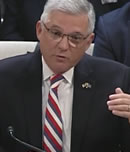Privatization Concerns

Richard Stone, MD, executive-in-Charge of VHA
Another fear that Stone said could be put to rest was that expanding community care access would be a step toward privatizing veterans’ care. As of October, VA had completed more than 56 million ambulatory appointments, a 1.6 million (3.1%) increase over the same time frame in 2018.
“VA is not privatizing, and veterans are choosing VA,” Stone declared.
Asked if the standards VA has set for veterans obtaining appointments with non-VA providers are achievable and working as intended, Stone enthusiastically said that they were. “In mental health, we have a 20-day access standard, and it’s being met at 139 of 141 sites. In primary care, 93 of 141 sites are meeting the primary care standard of 20 days,” he pointed out.
Where VA is struggling, Stone said, is in specialty and subspecialty areas of care. “These are the same areas where the rest of the nation is struggling,” he noted.
Metrics of care after the veteran goes to the community provider will be harder to come by, Stone admitted. “We are the most transparent healthcare system in the nation, but it’s very difficult to see timeliness in the community. It’s also difficult to see quality outcomes.”
A more recent concern of legislators is how veterans are utilizing the urgent care provisions of the MISSION Act, which allow qualified veterans to visit in-network urgent care facilities. For most priority groups, the first three visits during a calendar year are free, with each subsequent visit requiring a $30 copay.
According to VA, since June 6, veterans have made 16,000 visits to urgent care facilities. Legislators have expressed worries that veterans will use urgent care as a replacement for ongoing primary care.
According to Stone, VA has up-to-date data on urgent care usage from TriWest, one of two companies contracted to administer VA’s community provider network. That data shows that, for the most part, veterans are utilizing urgent care for appropriate conditions.
“We know we have 11 veterans who have already used urgent care 10 times in the first three months, but the vast majority have used it appropriately. Well over 90% have used it one or two time, and it’s a great benefit for them,” Stone said. “We need to track this closely and help care manage the 11 veterans who have been there 10 times already.”
Most community care usage has been from veterans seeking specialty care rather than primary care, which is what VA intended, he explained.
Stone confessed that, while the rollout is going as planned, he still worries about sending veterans to nonproviders and the possibility that they could be driven by money rather than serving veterans.
“I worry about the fact that there is a perversion in the commercial sector in the incentives toward care,” he told legislators. “We have been very gratified by the fact that we’ve been able to drop the usage of opioids dramatically and provided a safer environment. Therefore, we must deliver a network that really does provide mental health primary care in a manner that delivers the care integration veterans deserve.”
To accomplish that, VA will be leaning on the companies overseeing its community networks—TriWest and Optum. The CEOs of both companies were also on hand to testify and assured legislators that they were placing the health of veterans above all other considerations. David McIntyre, CEO of TriWest, went so far as to say that there are some veterans who should not utilize community care.
“There are always veterans who should only be served by VA,” McIntyre told legislators. “Part of the trick over time is to figure out who they are and how do we make sure they’re first in line at VA and not third in line. We need to make sure the people who are most at risk for things that are unique to veterans always end up at VA.”

My experience with using Care in the Community over a half-dozen times is it takes on average six months to get an appointment. I am not aware what the standards for Care in the Community to schedule an appointment! I do support this program but it is a typical VA program that’s definition of success is vague at best!
The system is a disaster and wastes time for providers and veterans. Sometimes the vet waits longer for a community appointment or the community provider never gets them scheduled. Then they repeat tests that have already been done and do not communicate with the VA provider. We need to fund VA care so that VA can hire the providers it needs and care for the vets the way it was intended.